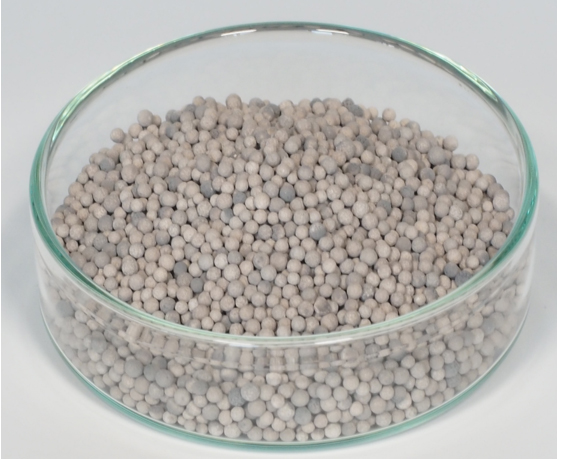Carbon Recycling Catalysts
![[Carbon Recycling Catalyst product image] (Top) TRC10, (Left) TRC40A, (Right) TRS30A](https://prod-cms-cache-bucket.s3-ap-northeast-1.amazonaws.com/wp-content/uploads/sites/images/ex/en/products/images/co2-recycling-catalyst/img_intro.jpg)
Carbon Recycling Catalysts by TANAKA
We contribute toward solving the issue of climate change by providing methanation catalysts—which generate methane that serves as a fuel from CO2, a global warming substance that is released into the atmosphere—as well as other catalysts such as carbon dioxide gas reforming catalysts and reverse shift catalysts—which generate CO and hydrogen that serve as chemical raw materials.
Carbon Recycling Catalysts Overview
■Features
- Provides various catalysts based on ruthenium, platinum, and rhodium
- High durability from use of precious metals
- High catalytic activity can be maintained even with low precious metal content, enabling the supply of catalysts at low cost
■Main products lineup
| Reaction | Product name | Precious metals | Particle size (sieve sorting) |
|---|---|---|---|
| Carbon dioxide gas reforming(H2O) |
TRC10 series |
Ru | Approx. φ2 mm |
| Carbon dioxide gas reforming(O2) |
TRC40A series |
Rh | Approx. φ2 mm |
| Reverse shift | TRS30A series |
Pt | Approx. φ2 mm |
| Methanation | TRC10 series |
Ru | Approx. φ2 mm |
- We request for the signing of a Non-Disclosure Agreement (NDA) when providing samples and information such as precious metal content.
- We also offer consultations regarding the trial manufacture and made-to-order production of customized catalysts tailored to customers’ specific needs.
Carbon Dioxide Gas Reforming Catalysts (H2O)
Hydrogen (H2) and carbon monoxide (CO), which serve as the raw materials for chemical products and fuel, are generated from carbon dioxide gas (CO2) and methane (CH4).
■Characteristics of carbon dioxide gas reforming
TRC10〔Ru〕
- H2 generation concentration,
SV-dependence![[Characteristics of carbon dioxide gas reforming] H2 generation concentration, SV-dependence test results graph](https://prod-cms-cache-bucket.s3-ap-northeast-1.amazonaws.com/wp-content/uploads/sites/images/ex/en/products/images/co2-recycling-catalyst/img_block02_03.jpg)
- CO generation concentration,
SV-dependence![[Characteristics of carbon dioxide gas reforming] CO generation concentration, SV-dependence test results graph](https://prod-cms-cache-bucket.s3-ap-northeast-1.amazonaws.com/wp-content/uploads/sites/images/ex/en/products/images/co2-recycling-catalyst/img_block02_04.jpg)
-
【TEST CONDITION】
Item Value(Unit) CO2/(CO2+CH4) 30.00% SV(wet) 2,000 – 4,000 /h S/C 0.4 Pressure 0.3MPa(G) - [Post-test catalyst]

- *Data for reference from laboratory experiments
- *This is approximate data as results are affected by factors such as catalyst evaluation conditions, manufacturing conditions, and usage environment.
Carbon Dioxide Gas Reforming Catalysts (O2)
Hydrogen (H2) and carbon monoxide (CO), which serve as the raw materials for chemical products and fuel, are generated from carbon dioxide gas (CO2) and methane (CH4).
■Characteristics of carbon dioxide gas reforming
TRC40〔Rh〕
- H2 generation concentration

- CO generation concentration

-
【TEST CONDITION】
Item Value(Unit) CH4 4.76% CO2 4.76% O2/CO2 0.1 SV 12,000 /h Pressure Atmospheric
pressure
- *Data for reference from laboratory experiments
- *This is approximate data as results are affected by factors such as catalyst evaluation conditions, manufacturing conditions, and usage environment.
Reverse Shift Catalysts
Carbon monoxide (CO), which serve as the raw materials for chemical products and fuel, are generated from carbon dioxide gas (CO2) and hydrogen (H2).
■Reaction characteristics of Reverse Shift Catalysts
TRS30A series〔Pt〕
-
【TEST CONDITION】
Item Value(Unit) CO2 5% H2 5% SV(wet) 48,000 /h
[Post-test catalyst]
- CO generation concentration

- *Data for reference from laboratory experiments
- *This is approximate data as results are affected by factors such as catalyst evaluation conditions, manufacturing conditions, and usage environment.
Methanation Catalysts
Methane (CH4), which serves as the raw material for city gas and such, is synthesized from carbon dioxide gas (CO2)—which causes global warming—and hydrogen (H2).
■Reaction characteristics of Methanation Catalyst
TRC10〔Ru〕
-
【TEST CONDITION】
Item Value(Unit) H2 75% CO2 19% N2 5% GHSV(h-1) 3,000~9,000 /h - CO2 conversion rate, SV-dependence

- *Data for reference from laboratory experiments
- *This is approximate data as results are affected by factors such as catalyst evaluation conditions, manufacturing conditions, and usage environment.
Methane combustion catalyst (sulfur-resistant)
■Features
- Allows combustion of methane at relatively low temperatures
- Enhanced resistance to sulfur, reducing deterioration of catalytic performance due to sulfur
■Main product lineup
| Product name | Active species | Shape | Features |
|---|---|---|---|
| CC41 | Pt/Ir | Honeycomb | High resistance to sulfur |
- We request for the signing of a Non-Disclosure Agreement (NDA) when providing samples and information such as precious metal content.
- We also offer consultations regarding the trial manufacture and made-to-order production of customized catalysts tailored to customers’ specific needs.
■Methane combustion reaction characteristics
CC41〔Pt/Ir〕
- SV-dependence

- Performance change when sulfur is introduced

-
【TEST CONDITION】
Item Value(Unit) CH4 2,000ppm O2 10% H2O 10% SV 25,000 – 80,000 /h -
【TEST CONDITION】
Item Value(Unit) CH4 2,000ppm O2 10% H2O 10% SV 50,000 /h S 1ppm
It exhibits sustainable performance even in methane oxidation containing sulfur.
- *Data for reference from laboratory experiments
- *This is approximate data as results are affected by factors such as catalyst evaluation conditions, manufacturing conditions, and usage environment.








